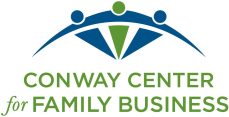Inside The Family Business: Boundaries and Best Practices
Frank L. Festi, Jr. – Rea & Associates, a Conway Center Service Provider
There are few things more gratifying to me than when I observe a successful family business already in its third (or later) generation of existence. It’s not a coincidence that these family-owned businesses are still going strong. Their survival is rooted in balance, as well as exceptional management and leadership.
Neil N. Koenig, Ph. D. provides business-minded individuals with an excellent reference book on issues facing family businesses, entitled “You Can’t Fire Me, I’m Your Father: What every Family Business needs to know for Success.”
Dr. Koenig maintains that the recognition and observance of critical boundaries and a dedication to best practices is essential to the survival of multi-generational family businesses.
Know Your Boundaries:
1. The Family/Business Boundary
The family business boundary is a day-in, day-out necessity. It is understood that there is a time for business and there is a time for family. This boundary serves to prevent interference between these two worlds.
This quote from Peter Drucker serves as a good reminder for anybody with a family-owned business: “The family serves the business. Neither will do well if the business is run to serve the family. The controlling word in ‘family business’ is not ‘family.’ It has to be ‘business.’”
2. The Ownership/Management Boundary
This boundary is the most critical ownership issue that families need to work out – during family meetings. It recognizes that just because someone is an owner doesn’t mean that person has to run the business, or even that they should run it.
- Ownershipis about who you are. Management is about talent and skill and what you can do.
- Ownershipis about the big picture for the future. Management is about daily implementation of it.
- Everybody has a place. According to Dr. Koenig, by the third generation of ownership, professional management, a professional board of directors and an ownership board (family business council) all play important roles within the family business.
Family Businesses Should:
- Lead
- Lead from the top and run from the bottom, according to Sam Walton.
- Hire and groom people for leadership who can get the job done and who can relate to people in a manner that earns their following.
- Create a culture where everyone can succeed and grow.
- Clearly articulate the company’s purpose, values, direction and current business goals.
- Get out of the way!
- Place Customers In The Drivers Seat
- Pursue quality to satisfy customer demands.
- Compete to foster a radical devotion to the customer’s wants and needs.
- Continue to find new customers and hang on to them.
- Provide Employees With More Responsibility
- Nothing motivates like responsibility, therefore in an effort to teach employees the financial realities of business, owners should give more responsibility and decision making authority those employees who are closest to the customer. The more responsibility employees have, the more responsible they are inclined to become.
- Every employee should approach their job like a business person – not just a few people at the top.
- Adopt Merit-Based Rewards
- Link employment and reward to merit.
- Clearly communicate priorities.
- Train and cross-train all employees.
- Provide meaningful performance feedback to all employees – positive and negative.
- Reward employees with continued employment. Pay bonuses to those who exceed goals and expectations. Coach those who fall short and advise those who are not willing to perform about companies that may be better suited to their own standards.
Since it was originally published in 1991, “You Can’t Fire Me, I’m Your Father: What every Family Business needs to know for Success,” by Neil N. Koenig, Ph.D., has provided valuable insight into the success and challenges faced by family-owned businesses.

